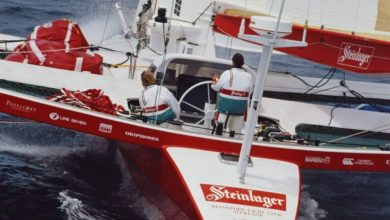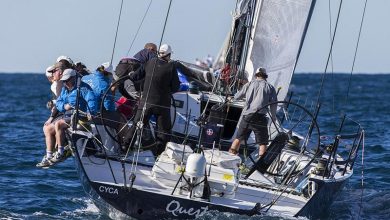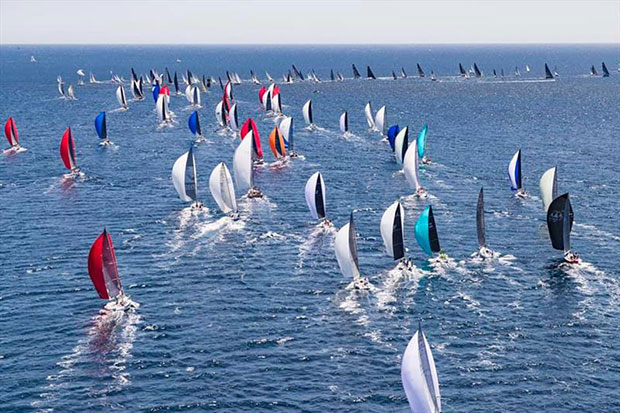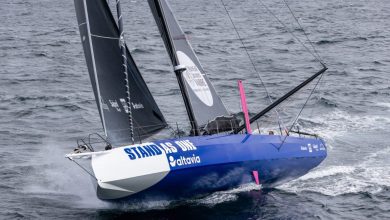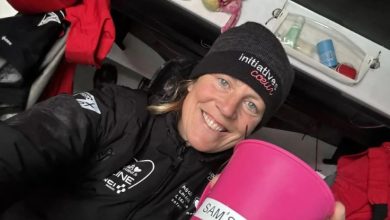SVR-LAZARTIGUE & Kresk4Oceans
SVR-Lazartigue is a sailing yacht with a length of 32.0m. The yacht’s builder is MerConcept from France who delivered superyacht SVR-Lazartigue in 2021. The superyacht has a beam of 23.0m and a volume of 50 GT.
The sport boat yacht features exterior design by VPLP Design and MerConcept , while her interior was penned by VPLP Design and MerConcept , with naval architecture by VPLP Design. The yacht SVR-Lazartigue has a carbon fibre hull and carbon fibre superstructure. She has a top speed of 45.0 kn.
On the ranking of the largest yachts in the world, SVR-Lazartigue superyacht is listed as number 4660th. She is the 1st-largest yacht built by MerConcept . The owner of yacht SVR-Lazartigue is shown in SYT iQ and is exclusively available to subscribers. On SuperYacht Times we have 3 photos of yacht SVR-Lazartigue .
SVR-Lazartigue is currently not for sale, but there are currently 2008 yachts for sale in the world. It is not known if yacht SVR-Lazartigue has a superyacht infotainment system by YachtEye.

François Gabart is back on the Route du Rhum 2022 with a new boat and a new sponsor. Despite disagreements with the Ultim Class, he has obtained a waiver to line up on the starting line and intends to win.
After the breathtaking finish of the last edition, would you say that you have a revenge to take?
Not at all. I’m not comfortable with the word revenge. It’s a new race, a new story, a new project and a new boat. I’m very happy to be at the start of this new edition and to know that I’m playing for the win. I have a beautiful boat, a beautiful project. It’s a beautiful race with a great level.
It’s nice to be in the game to try to have a finish like last time. It’s within the realm of possibility.
I have very good memories of the last edition, even if I didn’t finish with the result I had imagined. I experienced something quite extraordinary, upwind with Francis. Four years ago, we experienced major technical problems. It wasn’t easy, but I’m happy with what we were able to do with the team upstream, in preparation, and me on the water. I have no regrets or remorse. I want to do the best I can, without erasing what I experienced in the last edition.

How far have you got with your boat? Since its launch, have you made it evolve?
I’m still getting the hang of it, and that will be the case again in the Route du Rhum. It’s a complex boat. It takes several years to get to grips with these boats. I’ve come a long way in the last year or so, but there’s still a lot of work to do. I’m going to continue to progress during the Route du Rhum. There are still a lot of things to do.
I’m very happy with the job we’ve done so far in the conditions we had. I took advantage of each navigation to progress and improve.
We’ve done a lot of little things, but no big changes. In terms of systems and ergonomics, it is different from its launch and it will probably be different in a while.
What is your assessment of your sailing aboard SVR-Lazartigue? Is it a real advantage to sail protected? What are the differences with your old Macif ?
In terms of ergonomics and protection, the boat has progressed a lot. We are very happy with what we have been able to do. We are sailing at high speed, in safety, with a very good visibility on the environment. It’s been a long time since I sailed a boat with such a comfortable helm and watch position, so protected and with good visibility. It requires new tools, new reference points. With this new boat ergonomics, we think we are going in the right direction.
The objective was to fly a little earlier. We gained 4 to 5 knots for the takeoff of the boat. Before, we were taking off at 25 to 30 knots of boat speed, now we take off at 20 to 25 knots. This is positive and allows us to take off when there is less wind. We have made a lot of progress in all the points of sail where the boat is going fast, with high apparent wind speeds, where we need a lot of power and a good moment of recovery.
It’s always difficult to compare the performance of the boats, but it’s certain that we’ve passed a level in these conditions. We have progressed a bit everywhere. I think the previous boat was complete, balanced in its performance and I think this one is too.
Four years ago, I had a good knowledge of the boat’s settings and the ability to sail to its full potential. Today it’s not the case. There are still a lot of things to discover, adjustments to find. We feel that she has an interesting potential.

Have you done anything for solitaire?
Mainly in terms of ergonomics. It’s not the same cockpit as on the Jacques Vabre 2021 or on crewed races in the future. The ergonomics are designed to be efficient and effective for single-handed racing at the helm, at the chart table, and on the watch. It’s very important to keep up with the high speeds of single-handed racing.
We also made some technical changes: sails, appendages, control systems… with the aim of going fast single-handed. The boat has to be as easy as possible to adjust to the precise settings that a single-handed sailor cannot do all the time. We need to go fast without too much investment and physical energy. We opted for simple sail change systems, so that the boat can go fast in a straight line without major changes to the appendages.
How did you prepare for this race?
We tried to sail as much as possible this year. We really needed to sail. We did a nice tour of the Mediterranean in the spring, with a nice crew record during which we pushed the boat for just under a dozen hours. It was a great experience to push the boat in not so easy sea conditions. I also did a few solo exercises to familiarize myself with this format. I also did my qualification on the way back from the Mediterranean.
Recently, I have been doing more qualitative sailing for the Route du Rhum. Single-handed sailing with maneuvers, to try to make life more complex when you’re alone, to be in conditions closer to the race. The idea was to make the situations more complex so as to be ready for all scenarios. We regret not having been able to do some racing beforehand. But we sailed with Yves le Blévec and Arthur Le Vaillant. I’m certainly looking forward to sailing with all these nice Ultims boats.

Have you followed the different races and what do you think of the competition?
Reading the races this year, it’s hard not to see Gitana as a reference. It has won every race for the past two years. It’s an extremely fast boat, with good reliability. The new boats are showing, more and more, an ability to come close to performance, or even to go faster than Gitana in certain conditions and wind strengths. It’s quite exciting and interesting.
The level is quite homogeneous. There are 4, 5, even 6 boats with performances that should be quite close. But there are still a lot of unknowns and older boats. Francis proved it with panache 4 years ago, he was less fast on paper, but capable of sailing at his full potential without too much risk of breakage. These boats can win if newer boats have problems. There are great boats and great ingredients for a great race.
How do you assess the risk of not finishing on a breakage? Do you work on navigation modes in a race in degraded mode?
Sailing remains a mechanical sport, all the more so in difficult conditions, where you can’t control it all the time. It’s never easy to sail around the world or in a transatlantic race. Even if we progress, we are always confronted with reliability issues. Our boats would be unbreakable if they were heavier. We always take risks when we innovate and we develop boats like this one to win the Route du Rhum.
If you look at all the winners of the Route du Rhum, since the first race, they all had innovative boats, and took risks. Francis’ boat in 2018 was not the newest, but he is a 3-time Route du Rhum winner.
We take risks in areas that do not affect the integrity of the boat, in places where if the element breaks, we can continue to move forward or sail. Sometimes we have a degradation of performance, but this is not necessarily the case. For all the electronic and mechanical systems, we have a back-up. We can use another element in the same way.
You have to have plans B, C, D, sometimes with a diminishing level of performance. This was my case 4 years ago, with appendage problems. But my boat continued to float and to sail. You have to have repair solutions on board. We have quite a few systems on board, some of which we can block. We may not be in the same tuning ranges as at the start, but we will finish the race on a boat with as much integrity as possible.

What’s next in the program? Are you preparing an alternative scenario if your boat is not homologated? A Jules Verne Trophy?
It has been certified several times, but it’s true that there is some uncertainty about the rest of the program. Today, we are not thinking about that, because there is a beautiful Route du Rhum. In any case, we have lots of ideas to make her sail. We hope to race him, with as many friends as possible. In any case, we want to be on the water and give this boat what it deserves, and to perform well.
by boatsnews.com

